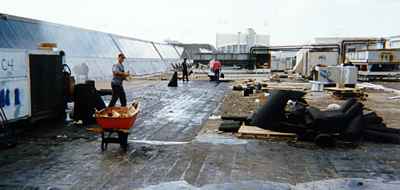|
 |
Conventional
Roofing |
|

 |
What is hot tar...built-up? |
|
Commonly referred to as a Tar & Gravel roof. By today's
codes it consists of the use of steep asphalt (normally type
III) instead of coal-tar pitch as used by our forefathers. The
type of substrate dictates the type of insulation and base sheet
materials to be used, plys of felt (generally 3, 4, or 5) are
installed by integrating hot asphalt between each ply installed,
to build an overlapping, redundant system. This system is then
flooded with more hot asphalt in order to seed the application
of 400 to 600 pounds of gravel per 100 square feet (1 square).
We also
provide emergency mobilization during hurricanes and other natural disasters,
serving the entire Gulf Coast Region as well as the Atlantic Coast. Our
emergency dry-in teams are able to temporarily repair your buildings at
the rate of 10,000 square feet per crew per day and more, by utilizing
the SPF roofing systems.
 |
What is modified bitumen (torch down & hot mop)? |
|
A waterproofing
membrane either granulated or smooth surfaced composed of asphalts blended
with polymers and reinforced with polyester fabric or fiber glass mat.
Torch down refers to the application method of using heat from the torch
to melt the adhesive embedded in the material. Hot mop refers to the application
method of using hot asphalt from a kettle as the adhesive.
 |
What
are the different types of shingles? |
|
You can
select from many materials from wood shakes to clay tile to slate. But
by far the most practical choice, accounting for nearly two-thirds of
all re-roofing in the United States, is asphalt shingles. Asphalt shingles
are named for the sticky, tarry, water-repellent substance that holds
them together. They are basically large rectangular mats, about 1 x 3
feet, made of cellulose or fiberglass and impregnated or coated with asphalt.
They are
also coated on the bottom surface with sand, talc, and other mineral filters
for stiffness and to eliminate the stickiness of the asphalt. Typically
the top surface is coated with granules colored with a hard ceramic glaze.
Besides adding color, the granules protect the asphalt from the suns ultraviolet
rays, and their weight beefs up the shingles resistance to wind.
 |
Roofing
Systems |
|
|
 Hi-Tech
Roofing Systems Hi-Tech
Roofing Systems
Spray polyurethane foam & coatings
Waterproofing for metal roof
Waterproofing
for metal buildings
Cold
storage and freezer Insulation
Consulting
and project management
Read More
|
 |
 Conventional
Roofing Systems Conventional
Roofing Systems
Hot
tar/built up
Modified
bitumen
Shingles
(all types)
Custom
tile (all types)
Cold process coatings
Read More
|
|
